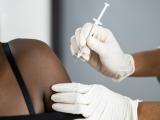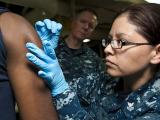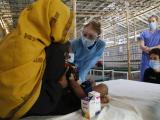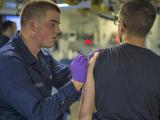Oct 29, 2003 (CIDRAP News) To bring coherence to a poorly coordinated national effort, the United States should focus its current bioterrorism preparedness program on four specific threat scenarios involving anthrax, smallpox, botulinum toxin, and foot-and-mouth disease (FMD), according to a report by defense consultant and former Navy Secretary Richard Danzig.
Danzig asserts that current biodefense efforts are muddled because the many agencies and groups involved lack a common understanding of the threat. To remedy that, he recommends that current planning focus on four specific hypothetical cases: an airborne anthrax attack, an airborne smallpox attack, dissemination of botulinum toxin in cold drinks, and dissemination of FMD among cattle, sheep, and pigs.
Danzig takes a stab at launching this planning strategy himself by analyzing the anthrax and smallpox scenarios and making several specific recommendations pertaining to warning systems and medical countermeasures. For example, he calls for the improvement of warning systems so that airborne anthrax spores could be detected and an alert issued within 8 to 10 hours after their release.
The report, titled "Catastrophic BioterrorismWhat Is to Be Done?" was published recently by the Center for Technology and National Security Policy at the National Defense University in Washington, DC.
A key reality that all biodefense efforts should recognize is that bioterrorists could rapidly "reload" and attack repeatedly within a short time, Danzig writes. "In this light, we must prepare for biological attacks repeated in different American cities rather rapidly after one another," he says. "Plan to defend against a campaign, not just an attack."
He writes that he chose the four threat scenarios on the basis of discussion with numerous experts. He calls them "broadly representative of the great majority of cases that should concern us" in the near term. "Build a portfolio of required capabilities from these cases," he recommends.
But because biological threats are likely to change, Danzig also suggests setting up a committee of scientists and intelligence officers to continually watch for and warn of possible new threats and to change the planning scenarios as needed.
The anthrax attack scenario envisioned by Danzig involves the use of a small commercial sprayer, perhaps mounted on a building, to spread several kilograms of weaponized anthrax spores over a large city on a calm evening. The resulting anthrax plume is assumed to infect at least 200,000 people up to 40 miles away.
Such an attack would cause other parts of the country to go on alert and would create a need for national guidance and coordination, Danzig writes. Demands on the president and Cabinet would be "immense." Accordingly, he recommends immediately setting up a team of leading expertsa "Biological Emergency Advisory Team"to support senior decision makers in the event of bioterrorist attacks. The team should have 50 to 100 members so it wouldn't be crippled by absences at any given time.
Danzig further asserts that development of an antibiotic-resistant strain of anthrax would be "quite easy." Consequently, the nation needs a "triad" of medical countermeasures: antibiotics, vaccines, and some other kind of treatment, such as an antitoxin, enzyme, or bacteriophage. He recommends expanding the stockpile of existing vaccine and speeding the development of a new vaccine.
Discussing systems to detect airborne anthrax, Danzig analyzes the problem of false alarms, which could cause "intolerable" economic and political damage and a reluctance to act on information. In view of this problem, detection systems should be subject to two sets of requirements concerning costs, false-positive rates, and sampling ratesone set for normal circumstances and another for use after an initial attack. After an attack, authorities would probably increase their sampling because of the danger of further attacks. This would lead to more false-positives, but because of the higher threat, false-positives would be more readily tolerated. Accordingly, detection systems should be designed so that they can quickly be adapted to meet increased post-attack demands.
Current detection systems, the report says, would take from 1 to 2 days to spot an airborne anthrax attacktoo long to provide an "actionable warning" for an optimal response and only slightly less time than it would take for the first sick patients to start showing up in emergency rooms. The author recommends a goal of improving the detection systemsincluding nucleic acid testsso that they could provide a reliable alert within 8 to 10 hours. That would be fast enough to trigger an early-morning alert after an attack at dusk, considered the most likely time because of weather factors.
For the smallpox scenario, Danzig envisions an attack that would infect 200,000 people in the main exposure area, just as in the anthrax case. In his view, this situation would necessitate both mass national vaccination and a local effort to identify and vaccinate exposed people. "If mass national vaccination had not already occurred, it would be required in the wake of an attack because it would quickly be realized (and perhaps demonstrated) that the attacker could attack again and again in different places," he writes.
Available detection technology could identify a smallpox attack within 24 to 36 hours, he says. Theoretically, this would be soon enough to permit vaccination within 4 days after exposure, which could prevent disease or lessen its severity. But no federal, state, or local health authorities are capable of alerting and vaccinating civilians fast enough to take advantage of this window of opportunity. The Centers for Disease Control and Prevention has asked metropolitan areas to make plans to vaccinate 118,000 people per day in case of an attack, and the agency has a long-term goal of being able to vaccinate a million people in an area within 5 days, according to the report.
Danzig recommends setting the loftier goal of creating "an integrated federal system" capable of both detecting a smallpox attack and vaccinating the exposed population within 96 hours after the attack. Given adequate resources, such a system "should be feasible with existing technologies." But he qualifies this recommendation with the phrase "if a smallpox threat is judged to be significant."
If the goal of a 4-day alert and vaccination program can be achieved, it may not be necessary to offer smallpox vaccination to the public in the absence of any attack, according to Danzig. But alerting and vaccinating the public within 4 days will be difficult, he acknowledges. Therefore, he further recommends that if the threat of smallpox is considered significant, pre-event smallpox immunization should be offered to Americans whose health profiles indicate that they are not substantially at risk from the vaccine.
Danzig also recommends stepping up efforts to develop a safer smallpox vaccine and launching an effort to develop a test for diagnosing smallpox infection within 4 days after exposure. In the absence of an adequate detection system, such a test "could be an important means of reassurance or a trigger for immediate immunization."
In other recommendations, the report calls for evaluating biodefense efforts by looking at 10 "critical capabilities," such as detection, drugs and vaccines, decontamination, surveillance, civilian preparation, and consequence management.
Danzig R. Catastrophic bioterrorismwhat is to be done? Washington, DC: Center for Technology and National Security Policy, National Defense University, Aug 2003
















